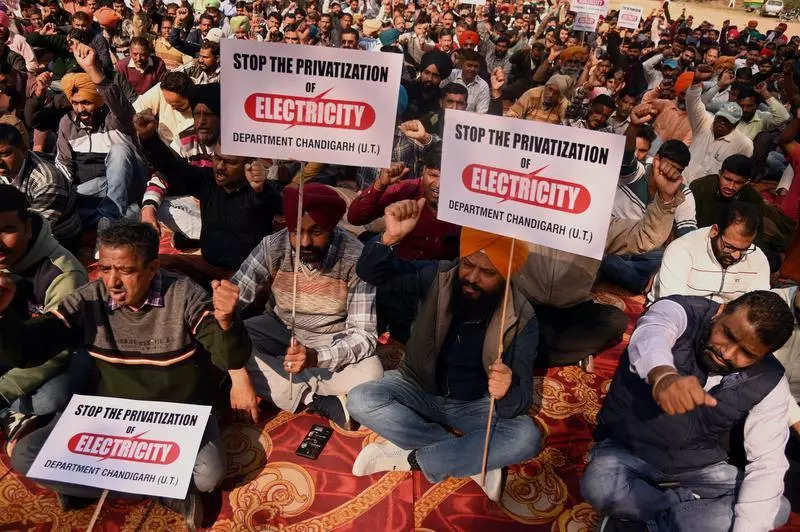Report by Kamgar Ekta Committee (KEC) correspondent

Vidyut Karmachari Sanyukt Sangharsh Samiti Uttar Pradesh and Rajya Upabhokta Parishad Uttar Pradesh have highlighted a very important recent experience of failed privatization in the power sector. It is important to publicize this among all the working people of our country.
Past experience in Uttar Pradesh
In Agra and Greater Noida, where electricity distribution was privatized, both consumers and the Uttar Pradesh government have lost thousands of crores over the years. In the case of Agra, Torrent Power Company has reportedly pocketed electricity revenue of Rs. 2,200 crore from the UP Power Corporation. Not only that, but the UP Power Corporation has reportedly already accumulated losses of more than Rs. 10,000 crore as it is being forced to supply power to Torrent Power at a rate that is lower than its investment.
Similarly, it is reported that the UP government is fighting a case in the Supreme Court to cancel the privatization agreement with Noida Power Company Limited (NPCL) due to the company’s pathetic performance in Greater Noida, where it distributes electricity.
Workers are asking why the UP government wants to privatise Purvanchal and Dakshinanchal Vidyut Vitaran Nigam when the state has already experienced two failed cases of privatization.
Chandigarh distribution privatization failed in 6 months!
Power sector workers, citizens, and workers and farmers of Chandigarh had been unitedly opposing the privatization of the Chandigarh distribution company for many years. They pointed out how Chandigarh’s discom was already generating surplus profit, with uninterrupted electricity supply of an excellent quality and one of the lowest AT&C losses in the country. Their struggle received massive support from across the country.
However, the Central government—which has full control of the Chandigarh Union Territory—at the behest of the big capitalists of our country, handed over the discom to the private Eminent Power Company Ltd (a subsidiary of Calcutta Electric Supply Corporation), leading to the formation of Chandigarh Power Distribution Ltd on 1 February 2025. But within 6 months since privatization, the service quality of electricity distribution has dropped dramatically. The President of Chandigarh Resident Welfare Associations’ Federation has said that especially poor citizens and domestic consumers frequently face power outages of 2 to 6 hours, which has never happened in the past. Even the Mayor of Chandigarh has reportedly said that after privatization, there is nobody to listen to customers’ plight, and the company’s helpline does not work properly. Moreover, Chandigarh Power Distribution Ltd is already seeking approval for a tariff hike, which residents are opposing. Citing an estimated revenue gap of Rs. 982 crore over 5 years from 2025-26 to 2029-30, the private company wants consumers to pay more. This estimate should raise questions, given that before privatisation, the Chandigarh discom was generating profits.
Very clearly, this recent experiment has also failed utterly. Despite such experiences, we should ask why the Central government, UP government and many other state governments are still going ahead with the drive of privatizing the power sector. Do governments—and the various political parties that form these governments—only care about the loads of profit that capitalist companies will make from this basic necessity of life—electricity? Can any other conclusion be drawn from these experiences?
The Vidyut Karmachari Sanyukt Sangharsh Samiti Uttar Pradesh has also pointed out that the Request For Proposal (RFP) document that was used for the privatization of the Chandigarh discom also served as the basis for preparing the Request For Quotation (RFQ) for Purvanchal and Dakshinanchal Vidyut Vitaran Nigam. In the light of Chandigarh’s experience over the last 6 months, can we expect the terms of the RFQ document to work in favour of consumers? This is the just question that workers are raising.
They have also pointed out that the Chandigarh power department’s property was worth more than Rs. 22,000 crore. However, the RFQ fixed the reserve price at only Rs. 124 crore for handing over this massive property to the winning private bidder. Finally, the property was sold for the measly sum of Rs. 871 crore, resulting in a huge loss of public money. Similarly, workers are pointing out that the RFQ used for inviting bids for Purvanchal and Dakshinanchal Vidyut Vitaran Nigam mentions a measly Rs. 6,500 crore as the base price, although the property of the two discoms is worth more than Rs. 1 lakh crore! This brazen loot of public money is another very important reason why working people of our country need to oppose the privatization drive!
